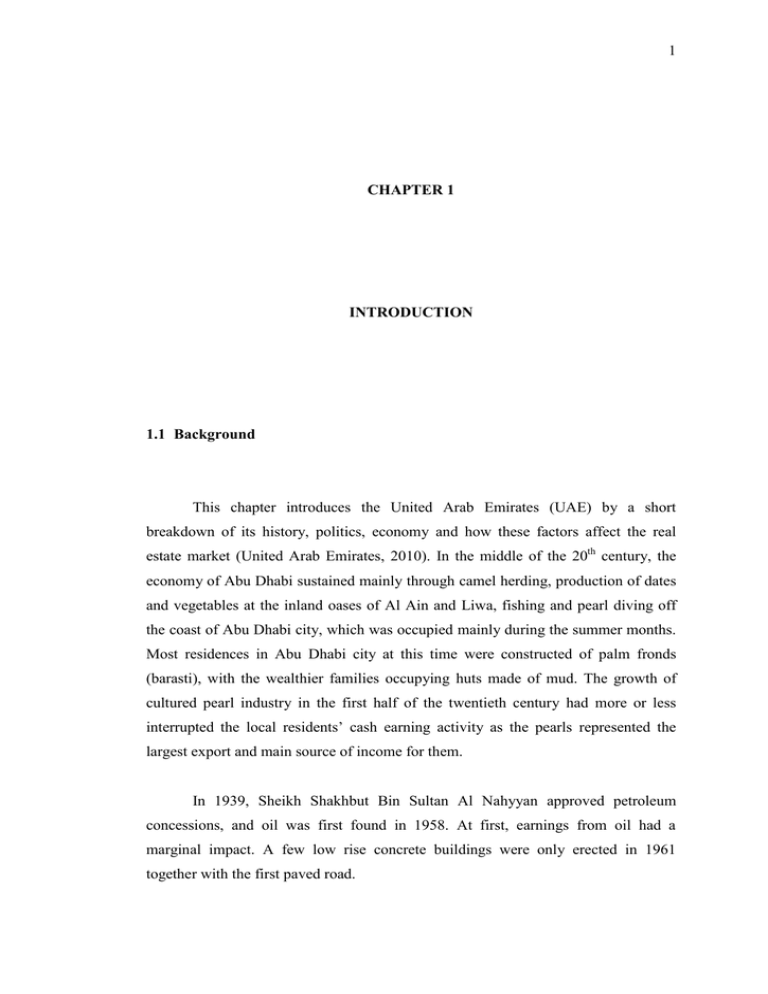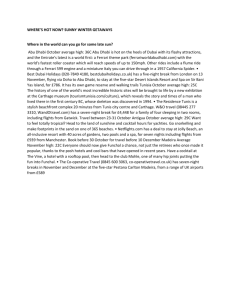1 This chapter introduces the United ... breakdown of its history, politics, ...
advertisement

1 CHAPTER 1 INTRODUCTION 1.1 Background This chapter introduces the United Arab Emirates (UAE) by a short breakdown of its history, politics, economy and how these factors affect the real estate market (United Arab Emirates, 2010). In the middle of the 20th century, the economy of Abu Dhabi sustained mainly through camel herding, production of dates and vegetables at the inland oases of Al Ain and Liwa, fishing and pearl diving off the coast of Abu Dhabi city, which was occupied mainly during the summer months. Most residences in Abu Dhabi city at this time were constructed of palm fronds (barasti), with the wealthier families occupying huts made of mud. The growth of cultured pearl industry in the first half of the twentieth century had more or less interrupted the local residents‘ cash earning activity as the pearls represented the largest export and main source of income for them. In 1939, Sheikh Shakhbut Bin Sultan Al Nahyyan approved petroleum concessions, and oil was first found in 1958. At first, earnings from oil had a marginal impact. A few low rise concrete buildings were only erected in 1961 together with the first paved road. 2 On August 6, 1966, Sheikh Zayed bin Sultan Al Nahyyan, who was the new ruler for Abu Dhabi Emirate, saw that oil wealth had the potential to greatly transform Abu Dhabi. He then carried on with his vision of developing the country. Figure 1.1 and Figure 1.2 depict photographs taken at Al-Khalidiah and the main street in Abu Dhabi respectively in 1966. Figure 1.1: Aerial Photo of Al Khalidiah, Abu Dhabi 1966 (Maribelecosystems, 2008) Figure 1.2: The Main Street in Abu Dhabi 1966 (Maribelecosystems, 2008). 3 In 1968, the British Government announced their withdrawal from the Arabian Gulf area by 1971. Sheikh Zayed was the main driving force in the formation of the United Arab Emirates. Oil wealth then continued to flow into the country post independence and banks, boutiques and modern high rise buildings quickly replaced the mud huts. Figure 1.3 shows the start of the construction of high buildings in 1970 and Figure 1.4 shows an image of Chornice in 2007 (Wikipedia, 2008) Figure 1.3: Abu Dhabi Corniche 1970 (Wikipedia, 2008) Figure 1.4: Abu Dhabi Corniche 2007 (Wikipedia, 2008) 4 Abu Dhabi's real estate started to bloom under the leadership of the son of the UAE's founder, Sheikh Khalifa bin Zayed Al Nahyyan, following his father‘s death and the signing of the new Real Estate Law by the new President in 2005. Sheikh Khalifa Bin Zayed Al-Nahyyan is the president of UAE since 2004. For the first time, the new Real Estate Law provides the country‘s population the right to sell and transfer lands in Abu Dhabi Emirate (Maloumat, 2008). The modern nation of the United Arab Emirates (UAE) is located on the southern tip of the Arabian Gulf, in between Saudi Arabia and Oman. Originally the Gulf was inhabited by a series of ‗Sheikhdom‘ principalities ruled by different, often competing Arab monarchs. As such, no single authority controlled the Gulf straits and it became plagued with criminal and pirate activities. This was a great distress to Britain as it was adversely affecting its trade routes to and from India. As a result in 1853, The Perpetual Maritime Truce was signed and the sheikhdoms that participated later were called to the Trucial States. Piracy was outlawed along the Gulf and on land. The British obligated their navy to patrol the Gulf, and as in many other British territories intra-sheikhdom disputes were adjudicated by the British forcing a new era of cooperation between the Sheikhdoms. These ties were further solidified in 1892, when the sheikh signed another treaty with Britain promising to divest land only to Britain and that it would be the only foreign power with high level relationships with the Sheikhdoms. In return Britain increased its military commitment by continuing its coastal protection duties and assisting with terrestrial defenses. Then in 1971, the British terminated its protectorate arrangements with the Trucial Sheikhdoms and with Bahrain and Qatar, who were also British protectorates. The Sheikhdoms then tried unsuccessfully to form a united Arab union with Bahrain and Qatar, and then went in their separate ways. Later that year the remaining members officially formed the UAE, a federation comprised of seven emirates. Federal power comes ultimately from each emirate, where the Supreme Council of Rulers (comprised of representatives of each ruling emirate) elects the important offices of the Federal state. 5 1.2 Problem Statement There is a common saying that says a picture is worth a thousand words (Can, 1998). GIS is a tool used in map making and as a visualization aid, for certain designated areas. In real estate, it is understandable that location is a fundamentally important criterion in determining the current and potential value of a property. Spatial factor is then vital in influencing a decision making process and GIS is undoubtedly useful in this aspect (Zeng and Zhou, 2001). The purpose of this study is to develop house preference model (HPM) for the point of interest (POI) and its impact to real estate using GIS. Finding a place to live in is a critical choice because the decision made could not be changed due to the high price of the property and its location. This study is conducted to help people to make a decision in renting a property that has the best location and the best price according to their needs and affordability. This could also be a ground work in assisting clients to select optimal home selection. Location is one of the most significant factors in choosing a real estate object (e.g. flat, office, building parcel). Surroundings characteristics of the real estate including ecological indicators, traffic location and level of infrastructure development should be given due attention by developers and realtors. GIS makes possible mapping of the location of surrounding objects and fundamental analysis of its location (Kononova and Nitonova, 2005). Most clients experience frustration, exhaustion and poor satisfaction. Location does tremendously play a major role in the decision making process. Today, buyers may get the right product with the right price but may not necessarily get the location they desire. This is very discouraging to the buyers, hence, resulting in retrievals from the market. This phenomenon is mostly due to the absence of a comprehensive database about the apartment promoters and their projects and most buyers prefer to choose from a variety of choices offered to them (Raghavendran, 2001). 6 The managing director of a property management company (Asteco), Andrew Chambers, once in 3rd of May 2009 told the Gulf News that ―at present there is an acute shortage of accommodation with quality at an affordable price range and there have been significant increases in rents‖. According to data from Asteco, the average rent (June 2006) of a one-bed-room apartment in the capital is Dh 53,000, two-bedroom apartments are Dh76,000 and three-bed-room apartments are Dh127,000. From June 2005 to June 2006, rents have increased by 33 per cent for single-bedroom apartments, 23 per cent for two bedrooms and 30 per cent for three bedrooms. However, there are apartments in some areas where rents are lower, but they are rising, fuelling inflationary pressures. Apartment and houses renting has a high demand and a low supply rate in Abu Dhabi. 1.3 Aim of Study The aim of this research is to model House Preferences Model (HPM) for the Point of Interest (POI) in the study area, and its impact to real estate, by using geographical information system (GIS) to find optimal place to rent in United Arab Emirates, based on a case study of Abu Dhabi Island. This is carried out by integrating the existing decision support system, using analytical hierarchy process (AHP), and GIS operating environment in ArcGIS. 1.4 Objectives of Study The aim of this study is fulfilled through the following objectives: 7 i. To define the spatial preferences to select optimal house to rent based on literature review and questionnaires. ii. To determine spatial preferences for housing rental market survey. iii. To develop housing preferences model (HPM) using AHP and spatial preference for house selection by using Geographic information systems. The model and map result from the study will serve two applications: i. For purchaser, renter and individual: As a consultant to locate optimal initial potential for the house area and evaluate available choices by weighting functions according to the customers' preferences. ii. For real estate agent and broker: As a tool to sell, manage and promote properties. 1.5 Scope of Study The scope of this study is to modeling GIS-DSS for POI analysis for optimal house selection to improve the current house selection practice, improve the accuracy and reduce the searching cost. The location enriched by POI database; allows users to view and analyze selected POI data in Abu Dhabi area. This study focuses on the environment surrounding the house that affects the selection of the house such as schools, universities, hospitals, parks, shopping centers and other point of interest which people need to live their daily life. By using Distance Analysis Functions in ArcGIS, user could be assisted to choose a house that has the biggest weight and to rank the entire selections from most likely match to lowest match. 8 1.6 Study Area Abu Dhabi Island in the northwest of UAE was chosen as the area of study, which is surrounded by Arabian Gulf and connected to the main land by Al Maqqta Bridge (main bridge) and Mussafah Bridge and a highway to other cities. Abu Dhabi is the capital of United Arab Emirates with a population of 896,751 calculated in 2009 (world-gazetteer.com). Abu Dhabi is one of the most popular emirates to purchase or rent a property due to many reasons including affluent reputation, coastal location and enticing weather. Rental prices have risen considerably in the past years because the demand currently outweighs the supply. The city is modern and it is growingly creating its own distinctive style. Abu Dhabi is laid out on a grid pattern and there is a very high density of buildings along the seafront area known as the corniche, where it is normal to see 20-storey, high-rise buildings. Apartment renting has a high demand and a low supply rate in Abu Dhabi, which sees a tremendous hike in rental prices. Serviced apartments are scarce and far between, situated within high-rise blocks. These apartments are usually fully furnished. There is no public transport system that usually passed through these serviced apartments, which means that all renters should individually own a car (abu-dhabi.world-guides.com, 2010). Abu Dhabi lies on a T-shaped island jutting into the Arabian Gulf from the central western coast. It covers an area of 16.5 x 12 km with a diversified resident density and constantly growing property market. Figure 1.5 shows the study area. 9 Figure 1.5: Study Area 1.7 Significance of Study A study of POI using GIS/DSS based approach was performed in this study that provides added value in choosing optimal house for rent based on POI impact. The results were compared with the previous selection of literature review whether the study approach provides significant methodological improvements in term of efficiency. Generally the significance of this study are as follows: 10 i. The study could provide better understanding of GIS in general, GIS application in real estate, optimal house selection and the relative potential location of places in Abu Dhabi Island. ii. The House Preferences Model (HPM) will be used as a decision support tool for optimal house selection by agent broker in Abu Dhabi Island to promote their properties by showing the impacts of POI in Geographical information systems with selected places. iii. The (HPM) Model may be used to delineate Abu Dhabi zones that are valuable to places of interest impact. iv. The Model may be used to rank Abu Dhabi zones according to POI impact. The results from the analysis may be used to clarify the spatial preferences, which in certain configuration leads to a longer or shorter distance of POI impact and if selecting parameters plays a role. v. The Model produced from this research could be used in the long term for other rapid growing cities and economy like Abu Dhabi. 1.8 Thesis Outline This thesis is structured and organized in the way that will guide the reader from the basic problems and concepts up to comprehensive understanding of GIS and DSS implementation. Chapter 1 Chapter one gives some introductory information about the problem, aim, objectives and the scope of the study. Also this chapter highlights the significance of studying GIS and DSS with regard to select a house in Abu Dhabi for renting. 11 Chapter 2 This chapter presents mainly the literature review, covering previous experiences or studies with the emphasis of GIS and implementation of DSS. Chapter 3 This chapter discusses the research methodology used, a description of the respondents, the procedures and statistical treatment utilized in analyzing the gathered data. Chapter 4 This chapter deals with the analysis of data. The results of the analysis were organized, prioritized accordingly and discussed. Chapter 5 This chapter discusses Abu Dhabi case study as a testing and implementation of distance methods of POI in Abu Dhabi. Also this chapter discusses the analysis and results of testing and applying POI and its impact on choosing the optimal place. 12 Chapter 6 This chapter includes the findings of this study. recommendations are given for future work in this field. Finally, some



